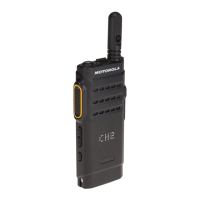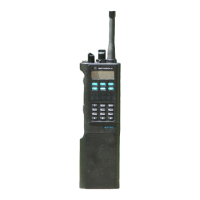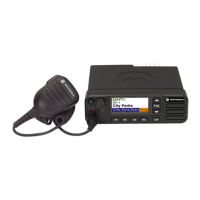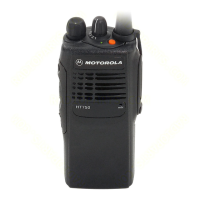Do you have a question about the Motorola ST7000 and is the answer not in the manual?
Explains graphic icons used for warnings and important notes in the documentation.
Describes special notations used to highlight information, like bold for keys and italic for tones.
Notes that the guide covers all features, but service provider customization may vary.
Lists technical specifications like voltage, current, power, temperature range, and ingress protection.
Provides a step-by-step procedure for removing and installing the radio's antenna.
Details the process of removing and reattaching the battery cover using a tool.
Explains prerequisites and procedure for installing a SIM card into the radio.
Details the procedure for safely removing a SIM card from the radio.
Provides instructions for inserting a microSD card into the radio's slot.
Details the procedure for safely removing a microSD card from the radio.
Step-by-step guide on how to insert and secure the battery into the radio.
Instructions on how to detach and remove the battery from the radio.
Explains how to charge the battery, either separately or attached to the radio.
Describes the visual indicators on the radio during battery charging.
Explains the audible alerts and indications for a low battery status.
Identifies and describes the physical controls and indicators on the radio.
Outlines the procedure for turning the radio on and its initial self-check.
Provides information on entering text and details the text entry icons used.
Explains the function of various navigation and input keys on the radio.
Describes the default home screen elements and their annotations.
Details the various icons that appear on the radio screen indicating status.
Provides guidance on how to hold the radio for optimal audio performance.
Explains how to switch audio output between the main speaker and earpiece.
Details the steps to switch between Trunked Mode Operation and Direct Mode Operation.
Explains how to manually select talkgroups and the process of network migration.
Lists features and their corresponding one-touch button assignments.
Describes Trunked Mode Operation (TMO) and its infrastructure requirements.
Steps to activate Trunked Mode Operation (TMO) on the radio.
Procedure for initiating a group call in Trunked Mode Operation.
Explains how network operators dynamically manage talkgroups over the air.
Explains how to make calls to landline, mobile, or extension numbers.
Describes the fallback mode when central network controller link fails.
Describes Direct Mode Operation (DMO) for direct radio-to-radio communication.
Steps to activate Direct Mode Operation (DMO) on the radio.
Details options for communicating via Gateway or Repeater in DMO.
Explains how radios communicate via repeaters in DMO to extend range.
Explains how radios communicate via gateways to connect DMO and TMO.
Explains Transmit Inhibit (TXI) Mode for disabling transmissions in RF sensitive areas.
Describes how to use Emergency Operations for critical situations.
Explains Emergency Group Calls, their priority, and initiation.
Procedure for initiating an emergency group call.
Explains using the Hot Microphone feature during emergency calls.
Procedure for terminating Emergency Operations.
Outlines the procedure for navigating the radio's menu system.
Identifies and explains the icons used for menu items.
Describes the menu item for initiating calls and entering numbers.
Covers sending and receiving text messages, including status messages.
Allows viewing and selecting active talkgroups on the radio.
Allows searching for entries in the radio's contact list.
Activates and manages the radio's Bluetooth feature.
Activates/deactivates scanning and views the active scan list.
Turns security features on/off and manages passwords.
Allows customization of various radio settings.
Enables or disables GNSS (Global Navigation Satellite System) location service.
Procedure for initiating private calls on the radio.
Allows creation and sending of new text messages.
Process of scanning for and connecting Bluetooth devices.
Enables encryption for communication, enhancing security.
Uses satellite information to determine radio's geographical location.
Provides interactions between radios with/without SIM cards for encryption.
Allows dispatcher to listen to radio conversations discreetly.
Provides overview of Bluetooth technology and its capabilities on the radio.
Explains how to make the radio visible to other Bluetooth devices.
Procedure for adding Bluetooth devices like headsets and sensors.
Details displayed sensor information such as battery and heart rate.
Uses satellite information to determine radio's geographical location.
Guidelines to improve GNSS feature's location calculation success.
Point-to-point calls between two TETRA radios.
Provides interactions between radios with/without SIM cards for encryption.
Feature to permanently disable the radio if stolen or lost.
Feature to temporarily disable/enable the radio if stolen.
Explains the radio's tone packs and how to listen to samples.
Lists and describes various radio tones for different events and notifications.
Details the status indications provided by the radio's LEDs.
Explains the LED indications for battery charging status.
Lists common messages displayed by the radio and their descriptions.
Provides a comprehensive list of radio messages and their troubleshooting advice.
Provides basic maintenance guidelines and warnings for the radio.
Tips to maximize the service life of the radio's battery.
Lists important warnings and cautions related to battery handling.
Explains graphic icons used for warnings and important notes in the documentation.
Describes special notations used to highlight information, like bold for keys and italic for tones.
Notes that the guide covers all features, but service provider customization may vary.
Lists technical specifications like voltage, current, power, temperature range, and ingress protection.
Provides a step-by-step procedure for removing and installing the radio's antenna.
Details the process of removing and reattaching the battery cover using a tool.
Explains prerequisites and procedure for installing a SIM card into the radio.
Details the procedure for safely removing a SIM card from the radio.
Provides instructions for inserting a microSD card into the radio's slot.
Details the procedure for safely removing a microSD card from the radio.
Step-by-step guide on how to insert and secure the battery into the radio.
Instructions on how to detach and remove the battery from the radio.
Explains how to charge the battery, either separately or attached to the radio.
Describes the visual indicators on the radio during battery charging.
Explains the audible alerts and indications for a low battery status.
Identifies and describes the physical controls and indicators on the radio.
Outlines the procedure for turning the radio on and its initial self-check.
Provides information on entering text and details the text entry icons used.
Explains the function of various navigation and input keys on the radio.
Describes the default home screen elements and their annotations.
Details the various icons that appear on the radio screen indicating status.
Provides guidance on how to hold the radio for optimal audio performance.
Explains how to switch audio output between the main speaker and earpiece.
Details the steps to switch between Trunked Mode Operation and Direct Mode Operation.
Explains how to manually select talkgroups and the process of network migration.
Lists features and their corresponding one-touch button assignments.
Describes Trunked Mode Operation (TMO) and its infrastructure requirements.
Steps to activate Trunked Mode Operation (TMO) on the radio.
Procedure for initiating a group call in Trunked Mode Operation.
Explains how network operators dynamically manage talkgroups over the air.
Explains how to make calls to landline, mobile, or extension numbers.
Describes the fallback mode when central network controller link fails.
Describes Direct Mode Operation (DMO) for direct radio-to-radio communication.
Steps to activate Direct Mode Operation (DMO) on the radio.
Details options for communicating via Gateway or Repeater in DMO.
Explains how radios communicate via repeaters in DMO to extend range.
Explains how radios communicate via gateways to connect DMO and TMO.
Explains Transmit Inhibit (TXI) Mode for disabling transmissions in RF sensitive areas.
Describes how to use Emergency Operations for critical situations.
Explains Emergency Group Calls, their priority, and initiation.
Procedure for initiating an emergency group call.
Explains using the Hot Microphone feature during emergency calls.
Procedure for terminating Emergency Operations.
Outlines the procedure for navigating the radio's menu system.
Identifies and explains the icons used for menu items.
Describes the menu item for initiating calls and entering numbers.
Covers sending and receiving text messages, including status messages.
Allows viewing and selecting active talkgroups on the radio.
Allows searching for entries in the radio's contact list.
Activates and manages the radio's Bluetooth feature.
Activates/deactivates scanning and views the active scan list.
Turns security features on/off and manages passwords.
Allows customization of various radio settings.
Enables or disables GNSS (Global Navigation Satellite System) location service.
Procedure for initiating private calls on the radio.
Allows creation and sending of new text messages.
Process of scanning for and connecting Bluetooth devices.
Enables encryption for communication, enhancing security.
Uses satellite information to determine radio's geographical location.
Provides interactions between radios with/without SIM cards for encryption.
Allows dispatcher to listen to radio conversations discreetly.
Provides overview of Bluetooth technology and its capabilities on the radio.
Explains how to make the radio visible to other Bluetooth devices.
Procedure for adding Bluetooth devices like headsets and sensors.
Details displayed sensor information such as battery and heart rate.
Uses satellite information to determine radio's geographical location.
Guidelines to improve GNSS feature's location calculation success.
Point-to-point calls between two TETRA radios.
Provides interactions between radios with/without SIM cards for encryption.
Feature to permanently disable the radio if stolen or lost.
Feature to temporarily disable/enable the radio if stolen.
Explains the radio's tone packs and how to listen to samples.
Lists and describes various radio tones for different events and notifications.
Details the status indications provided by the radio's LEDs.
Explains the LED indications for battery charging status.
Lists common messages displayed by the radio and their descriptions.
Provides a comprehensive list of radio messages and their troubleshooting advice.
Provides basic maintenance guidelines and warnings for the radio.
Tips to maximize the service life of the radio's battery.
Lists important warnings and cautions related to battery handling.
| Weight | 170g |
|---|---|
| Dimensions | 132 x 49.5 x 23.4 mm |
| Ingress Protection | IP54 |
| Operating Temperature | -30°C to +60°C |
| RF Power Output | 1W |
| Battery Life | Up to 14 hours (standard battery) |
| TETRA Air Interface | ETSI EN 300 392 |
| Security | Air Interface Encryption (AIE) |
| Power Output | 1W |
| Frequency Bands | 380-400 MHz, 410-430 MHz, 450-470 MHz, 806-870 MHz |
| Frequency Range | 380-400 MHz, 410-430 MHz, 450-470 MHz, 806-870 MHz |











